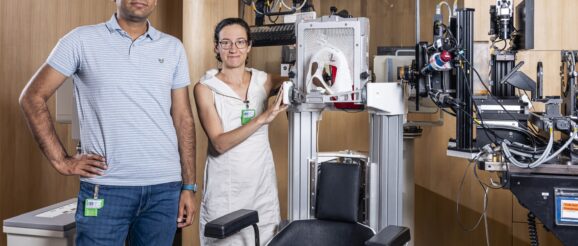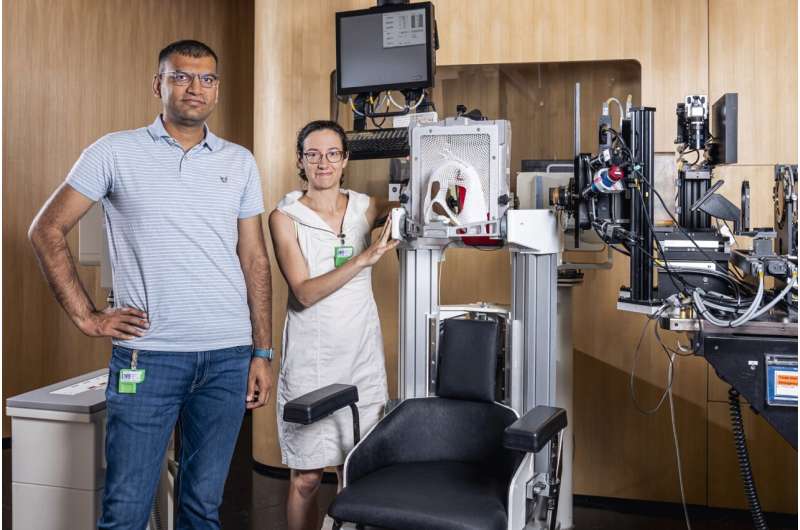Beamline innovation could enhance the potential of cancer treatment with proton therapy


Physicists have devised a way to achieve higher doses and shorter treatment times for cancer patients undergoing radiotherapy with protons, circumventing the problems of internal organ motions. They achieve this using a modification in the beamline, known as momentum cooling. Their study is published in the journal Nature Physics.
In and out, in and out: a person at rest takes a breath about every five seconds—maybe more, maybe less. This is a fact of life, but for proton therapy it is a problem.
The reason is that treating a moving target reduces the accuracy. At the moment, patients typically hold their breath for 10–15 seconds, posing a limit on the treatment time.
To get around this, researchers are trying to make treatment faster. But making treatment faster is not straightforward: it requires the prescribed radiation dose to be delivered to the tumor in a shorter time. This requires a higher dose rate, which is beyond the technological possibilities of most facilities. Now, researchers at Paul Scherrer Institute PSI’s Center for Proton Therapy have made a breakthrough that could make this possible.
A simple solution with a big impact for treatment
To understand the recent breakthrough, we follow the proton beam back to its generation in an accelerator called a cyclotron. The cyclotron produces proton beams at much higher energies than are needed for proton therapy. These are then stepped-down to clinically relevant energies, but in this process, much of the beam is lost.
Typically, to lower the energy, the beam passes through a material that leaves the energies in a spectrum. The lower energies are then selected using a slit, and the rest is effectively thrown away.
To increase the transmission—that is, the fraction of the beam that reaches the target, the researchers used a technique known as momentum cooling. In this, they replace the slit found in standard systems with a wedge, which converts the spread of energies to the desired lower energy instead of cutting it.
Ph.D. student and first author of the study, Vivek Maradia was convinced that such a fundamental adaption of the beamline was the solution needed. “I started thinking, why not use a material that makes energies that are low stay low, but energies that are high get shifted to a lower energy?”
Although the technique has been used in a modified form in other fields, such as for muon beams, it had never before been successfully implemented in proton therapy. Collaborating closely with experts in accelerator technology, the team could overcome technical challenges that had previously prevented its use in proton therapy.
“It’s a really straightforward and simple idea, but it gives a big impact in terms of transmission and therefore treatment,” adds Serena Psoroulas, senior scientist at PSI, who led the study as part of ongoing research efforts to increase the transmission of the beam.
From eye treatments to gantries
The researchers demonstrated momentum cooling in the eye treatment beamline, OPTIS2. Here, they could increase transmission—allowing to potentially reduce treatment time—by a factor of two. “It sounds like a small change, but the patients need to keep their eyes open without blinking for that time. So, for them, a factor of two is important,” says Psoroulas.
Following this proof-of-concept, the researchers are hoping to integrate it permanently into the beamline so that patients with eye tumors can benefit from shorter treatment times.
In simulations, the researchers incorporate the design into gantries—rotating parts of the beamline that allow the proton beam to be directed from multiple angles onto the patient. Here, they go on to show that their solution can enable transmissions up to one hundred times higher than achieved with typical energy selection systems.
Aside from circumventing the problems of internal organ motions during therapy, higher transmission has a knock-on advantage that the maximum cyclotron current can be limited, meaning that less shielding is required and costs can be reduced. The team have already received significant interest from vendors of proton therapy instrumentation who would like to implement the approach in gantries.
A means to achieve ‘FLASH’ treatments
The high dose rates and shorter treatment time possible with momentum cooling have another major appeal. Increasing evidence shows that using rapid, ultra-high dose treatments (so-called FLASH irradiations) favorably damages tumor tissue while sparing healthy tissue.
“The FLASH effect is still very much a subject of research. But momentum cooling would be a very effective way to exploit these benefits,” says Psoroulas.
More information:
Vivek Maradia et al, Demonstration of momentum cooling to enhance the potential of cancer treatment with proton therapy, Nature Physics (2023). DOI: 10.1038/s41567-023-02115-2
Beamline innovation could enhance the potential of cancer treatment with proton therapy (2023, July 6)
retrieved 7 July 2023
from https://phys.org/news/2023-07-beamline-potential-cancer-treatment-proton.html
part may be reproduced without the written permission. The content is provided for information purposes only.
